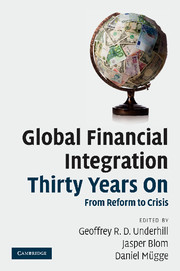Book contents
- Frontmatter
- Contents
- List of figures
- List of tables
- Notes on contributors
- Preface
- Acknowledgements
- List of abbreviations
- Introduction: the challenges and prospects of global financial integration
- Part I History and context: input, output and the current architecture (whence it came)
- 1 Financial governance in historical perspective: lessons from the 1920s
- 2 Between the storms: patterns in global financial governance, 2001–2007
- 3 Deliberative international financial governance and apex policy forums: where we are and where we should be headed
- 4 Finance, globalisation and economic development: the role of institutions
- Part II Assessing the current financial architecture (how well does it work?)
- Part III Does the future hold? Reactions to the current regime and prospects for progress (where is it going?)
- Conclusion: whither global financial governance after the crisis?
- References
- Index
2 - Between the storms: patterns in global financial governance, 2001–2007
Published online by Cambridge University Press: 02 December 2010
- Frontmatter
- Contents
- List of figures
- List of tables
- Notes on contributors
- Preface
- Acknowledgements
- List of abbreviations
- Introduction: the challenges and prospects of global financial integration
- Part I History and context: input, output and the current architecture (whence it came)
- 1 Financial governance in historical perspective: lessons from the 1920s
- 2 Between the storms: patterns in global financial governance, 2001–2007
- 3 Deliberative international financial governance and apex policy forums: where we are and where we should be headed
- 4 Finance, globalisation and economic development: the role of institutions
- Part II Assessing the current financial architecture (how well does it work?)
- Part III Does the future hold? Reactions to the current regime and prospects for progress (where is it going?)
- Conclusion: whither global financial governance after the crisis?
- References
- Index
Summary
Global financial governance is marked by a paradox: while financial markets are among the fastest evolving economic activities, their governance is most often reactive rather than forward-looking. As the previous chapter (Germain) in this volume confirmed, dramatic changes in the patterns of global financial governance are most often triggered by major financial crises which politicise the regulatory debate and pressure policy-makers to react. But once the storm has passed, both public authorities and private actors tend to be affected by what Reinhart and Rogoff (2008) have called the ‘this time is different syndrome’. Confidence is restored and complacency sets in until a new storm breaks out, opening a new cycle in the governance of financial markets.
Recent experience has been no exception. Between 1994 and 2001, the world financial system was shaken by a series of major crises emanating from ‘emerging markets’, most notably Mexico in 1994, East Asia in 1997–8 and Argentina in 2001. These crises prompted the leading financial powers of the G7 to launch a set of ambitious regulatory and institutional reforms to create a ‘new international financial architecture’ (NIFA). This reform agenda has been well-documented elsewhere (e.g. Eichengreen 1999; Kenen 2001) though post-2001 results have received less attention. After briefly outlining the NIFA project, we highlight in this chapter how the absence of serious international crises between 2001 and 2007 weakened the urgency of this reform agenda for G7 governments and scaled back the level of ambition, yielding greater reliance on market-based governance mechanisms.
- Type
- Chapter
- Information
- Global Financial Integration Thirty Years OnFrom Reform to Crisis, pp. 42 - 57Publisher: Cambridge University PressPrint publication year: 2010
- 1
- Cited by

